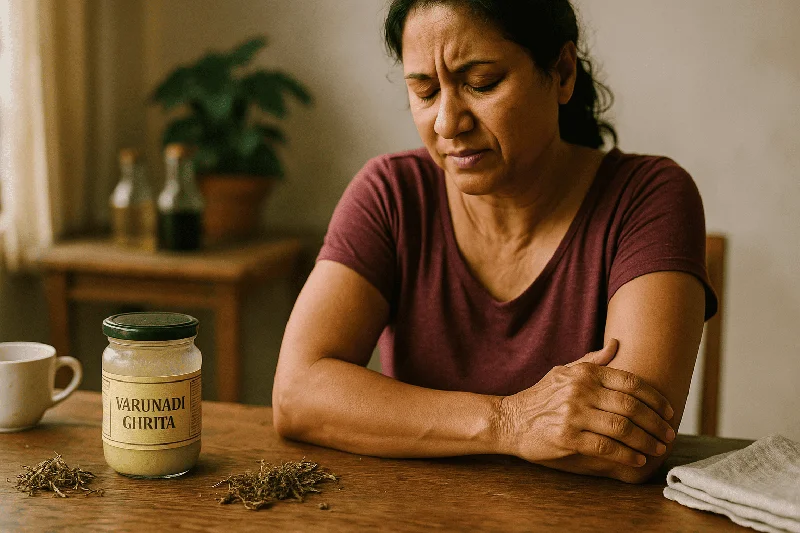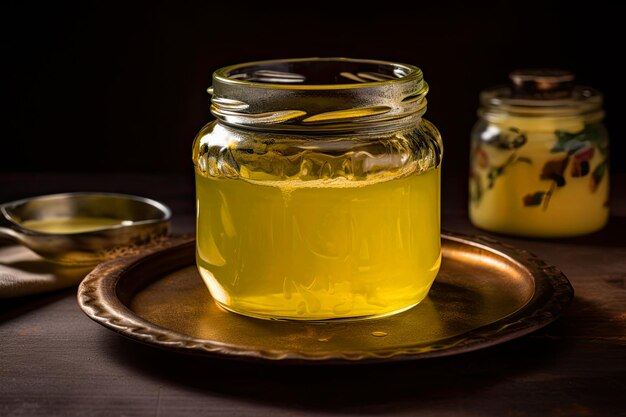Ask Ayurvedic doctor a question and get a consultation online on the problem of your concern in a free or paid mode. More than 2,000 experienced doctors work and wait for your questions on our site and help users to solve their health problems every day.
Shop Now in Our Store
Varunadi Ghrita – Ayurvedic Ghee for Joint Health, Detoxification & Rejuvenation

Introduction to Varunadi Ghrita
Varunadi Ghrita is a highly valued Ayurvedic formulation that combines ghee (clarified butter) with potent herbs, specifically selected to support joint health, detoxification, and overall rejuvenation. Traditionally used in Ayurveda, Varunadi Ghrita is known for its anti-inflammatory properties, making it highly effective in managing conditions like arthritis, gout, and joint pain. Additionally, its detoxifying nature helps purify the body, improving digestion, strengthening the immune system, and rejuvenating tissues. By incorporating Varunadi Ghrita into your wellness routine, you can tap into the healing benefits of Ayurveda and restore balance to your body and mind.
Historical Roots & Ayurvedic Significance
Varunadi Ghrita holds a special place in Ayurvedic medicine due to its effectiveness in treating Vata disorders, particularly joint and muscle-related ailments. Its name derives from Varuna, an herb traditionally used for managing urinary issues, and Ghrita, which represents the essential base of the formula, ghee. In ancient Ayurvedic texts, it was recommended for detoxification therapies and rejuvenation practices, promoting vitality and reducing the effects of aging. Its holistic approach to treating a wide range of issues, from joint pain to digestive concerns, reflects its enduring significance in Ayurvedic healing.
Key Components & Therapeutic Benefits
1. Herbal Composition
Varunadi Ghrita contains a unique blend of herbs and ghee, combining the medicinal properties of each ingredient to create a highly effective remedy. The primary herbs in Varunadi Ghrita include:
- Varuna (Crataeva nurvala): Known for its anti-inflammatory, diuretic, and detoxifying properties, it supports kidney health and alleviates joint pain.
- Guggulu (Commiphora wightii): A well-known herb in Ayurveda for its anti-inflammatory and anti-arthritic effects, helping in the treatment of joint pain, swelling, and stiffness.
- Ashwagandha (Withania somnifera): Revered for its rejuvenating properties, it promotes overall strength, reduces stress, and supports the immune system.
- Shatavari (Asparagus racemosus): A nourishing herb that balances hormones, boosts energy, and enhances vitality.
- Ghee (Clarified Butter): Acts as a carrier for the herbs, promoting absorption and providing lubrication to the joints and tissues.
2. Joint Health & Anti-Inflammatory Effects
Varunadi Ghrita is primarily used to promote joint health. The combination of Varuna and Guggulu works synergistically to reduce inflammation in the joints, alleviate pain, and prevent further damage. It is particularly beneficial for individuals suffering from conditions like arthritis, gout, and other inflammatory joint disorders. The ghee in the formulation helps lubricate the joints, reducing friction and improving flexibility and movement.
3. Detoxification & Rejuvenation
Varunadi Ghrita plays a vital role in detoxification by eliminating toxins (ama) from the body. Ashwagandha and Shatavari help rejuvenate the tissues, improve metabolism, and strengthen the digestive system. The detoxification process helps cleanse the body, supports the liver, and enhances overall vitality. Regular use of Varunadi Ghrita can result in improved skin health, better digestion, and a more youthful appearance.
4. Stress Relief & Immune Boosting
With Ashwagandha and Shatavari, Varunadi Ghrita also helps reduce stress and anxiety. These adaptogenic herbs promote mental well-being, helping to calm the nervous system and improve sleep quality. Moreover, the rejuvenating properties of these herbs help boost the immune system, making the body more resilient to infections and diseases.
How Varunadi Ghrita Works: The Science Behind the Formula
Varunadi Ghrita works through the combined action of its key ingredients, where Varuna and Guggulu provide anti-inflammatory and joint-relieving effects, while Ashwagandha and Shatavari promote rejuvenation and stress relief. The ghee acts as a carrier, helping the body absorb these herbs more efficiently. Ghee, being rich in butyrate, a short-chain fatty acid, nourishes the tissues, lubricates the joints, and supports the healing process. The overall result is improved joint mobility, reduced inflammation, better digestion, and an enhanced sense of well-being.
Choosing the Right Ayurvedic Remedies & Guidance
When using Varunadi Ghrita, consider the following:
- Consult Certified Ayurvedic Practitioners: Personalized guidance is important to determine the right dosage and ensure that the remedy is suitable for your health conditions.
- Opt for High-Quality Ghee: The ghee used in Varunadi Ghrita should be organic and of the highest quality to ensure that it is free from chemicals and additives.
- Purchase from Trusted Vendors: Always buy Varunadi Ghrita from reputable Ayurvedic pharmacies or certified practitioners to ensure authenticity and proper formulation.
Recommended Dosage & How to Use Varunadi Ghrita
The dosage of Varunadi Ghrita may vary based on individual needs and health conditions. A general recommendation is:
- Dosage: Typically, 1-2 teaspoons of Varunadi Ghrita can be taken once or twice daily.
- Consumption: It is usually taken with warm water or milk, as advised by an Ayurvedic practitioner.
- Topical Application: In some cases, Varunadi Ghrita may be applied topically to painful or inflamed joints for external relief.
- Professional Guidance: Always follow the specific dosage instructions provided by your Ayurvedic healthcare provider to ensure optimal results.
Potential Side Effects & Precautions
While Varunadi Ghrita is generally considered safe when used appropriately, there are some precautions to be aware of:
- Digestive Issues: Some individuals may experience mild digestive discomfort when using ghee-based formulations. Starting with a smaller dose may help minimize this issue.
- Pregnancy & Nursing: Pregnant or breastfeeding women should consult an Ayurvedic professional before using Varunadi Ghrita to ensure its safety.
- Allergic Reactions: Although rare, some individuals may be allergic to certain herbs or ghee. Discontinue use if any irritation or allergic reaction occurs.
- Start Slowly: Begin with a smaller dose and gradually increase to allow the body to adjust to the remedy.
Frequently Asked Questions For Varunadi Ghrita
How does Varunadi Ghrita benefit joint health?
Varunadi Ghrita is highly effective for joint health due to its anti-inflammatory herbs like Varuna and Guggulu, which help reduce pain and inflammation in the joints. The ghee also acts as a lubricant, improving joint flexibility and movement.
Can Varunadi Ghrita be used for detoxification?
Yes, Varunadi Ghrita plays a crucial role in detoxification by eliminating toxins from the body. It helps cleanse the liver and digestive system, promoting better metabolism and overall vitality.
How should Varunadi Ghrita be consumed for best results?
Varunadi Ghrita is typically consumed in a dose of 1-2 teaspoons daily, either with warm water or milk. In some cases, it may also be applied externally to relieve joint pain or inflammation.
Is Varunadi Ghrita helpful in reducing stress?
Yes, Varunadi Ghrita contains Ashwagandha, an adaptogenic herb known for its ability to reduce stress and anxiety. It calms the nervous system and improves sleep quality, promoting mental well-being.
Are there any side effects of using Varunadi Ghrita?
While Varunadi Ghrita is generally safe, some individuals may experience mild digestive discomfort. It is advisable to start with a lower dose and consult an Ayurvedic practitioner for personalized guidance.
How long does it take to see results from Varunadi Ghrita?
Results may vary depending on individual health conditions. For joint health, some individuals experience relief within a few weeks, while detoxification and rejuvenation benefits may take longer. Consistent use is key to achieving optimal results.
Where can I purchase authentic Varunadi Ghrita?
Authentic Varunadi Ghrita can be purchased from trusted Ayurvedic pharmacies, certified practitioners, or reputable online Ayurvedic stores. Always verify the quality and authenticity of the product before purchase.
Conclusion & Expert Insights
Varunadi Ghrita is a powerful Ayurvedic remedy that offers a range of benefits for joint health, detoxification, and overall rejuvenation. By combining the therapeutic properties of herbs like Varuna, Guggulu, Ashwagandha, and Shatavari, this ghee-based formulation works to alleviate pain, reduce inflammation, promote detoxification, and enhance vitality. With the guidance of a certified Ayurvedic professional, Varunadi Ghrita can be a valuable addition to your wellness routine, helping you achieve long-term health and well-being.
References & Further Reading
- Sharma, P.V. (1995). Ayurvedic Healing: A Comprehensive Guide.
- Lad, V. (2002). Ayurveda: The Science of Self-Healing.
- Journal of Ayurveda and Integrative Medicine for research on ghee-based therapies.
- National Institute of Ayurveda:
This article is checked by the current qualified Dr Sujal Patil and can be considered a reliable source of information for users of the site.



